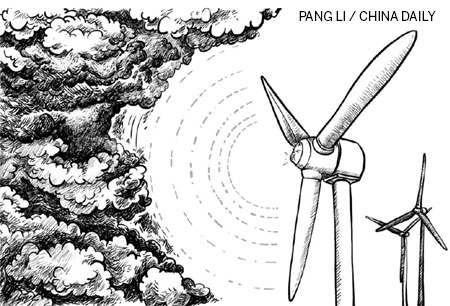Green around the renewable gills
Updated: 2013-02-18 08:05
By Haibing Ma and Wanqing Zhou (China Daily)
|
||||||||

China recently announced that it would join the International Renewable Energy Agency. China is a global leader in terms of installed capacity and investment in clean energy, though the acknowledgement of its status may come as a surprise to some, given the recent headlines on the country's air pollution. But in 2012, China invested $68 billion to develop renewable energies, 55 percent more than US investments, making it the largest clean energy investor in the world.
What is important for energy sustainability, however, is not only the scale of clean energy products and the amount of investment, but also the environmentally friendly approach through which the sector is built and operated. Although clean energy is certainly not to blame for a large part of the pollution problems, China's efforts to rapidly develop renewable energy have generated some environmental problems.
The lack of effective environmental policymaking and regulation has led to unsustainable practices in China's renewable energy sector that have cast a shadow on the country's "top spot" numbers.
While the production of renewable energy technologies constitutes a critical building block of a sustainable future, if it is not managed correctly, it can have some negative environmental impacts and sometimes can even create hazardous pollution.
Hydropower is China's largest renewable energy resource. Without incorporating sufficient ecological consideration into basin-level planning and engineering design (like fish ladders), however, dams built for hydropower projects can disrupt the natural flow of water that sustains balanced aquatic ecosystems. The country's heavily-dammed river system has led to a decrease or even extinction of some fish and cetacean species.
If wind turbines are not installed at proper sites, their blades can accidentally injure birds and bats. Wind farms, therefore, should be set up far away from the migration paths of birds and areas with high population density. But there are no traceable records to show that China has been conducting such impact assessments before planning new wind farms.
Similar cases related to pollution in China's clean manufacturing and renewable energy sector are still being reported, revealing loopholes in regulation, especially in enforcement.
In 2010, only 77 percent of China's wind turbines were connected to power grids. In 2011, despite the considerable growth in total installed capacity and the increase in turbines connected to grids (62.63 gigawatts and 47.84 gigawatts, respectively), the ratio remained the same. The winter of 2012 witnessed a great curtailment in wind. As a result, turbine idling is spreading like the flu, and many component manufacturers are cutting their staff, that is, if they haven't already suspended production.
In addition, the estimated proportion of solar polyvinyl installed capacity connected to grids is 72 percent (calculated with data from the State Electricity Regulatory Commission and Solidiance).
Various aspects have contributed to such a gap between installed renewable generation capacity and actual units connected to grids in China. Without proper guidance, blind investment fueled by renewable subsidies from the central government has saturated the wind and solar industries.
Local authorities' pursuit of renewable energy in some instances has reached absurd levels. As early as 2009, solar polyvinyl was used to justify land acquisitions in Xing'an, Guangxi Zhuang autonomous region, resulting in farm lands turning into empty-shell factories. Until last June, untrained villagers pretended to work on the assembly lines when government officials visited the facility.
This waste of not only electricity generation, but also of natural and human capital, further drives the industry away from true sustainability.
If not planned well with strict regulation, stringent implementation, and reliable technologies, the establishment of a renewable energy industry in China will not necessarily ensure true sustainability. Every step, from the industry's lifecycle to the institutional regulatory capacity, matters for the overall sustainability of the industry.
The good news is that the Chinese leadership is moving forward, though slowly and cautiously, to enhance regulatory enforcement, improve transparency and encourage media supervision.
Haibing Ma is the China program manager at the Worldwatch Institute,
and Wanqing Zhou is a research intern with the program.
Related readings:
China to cut unit industrial energy consumption by 5%
China eyes energy-saving products for clean economy
China to further tap geothermal energy
China nods energy consumption control target

 Li Na on Time cover, makes influential 100 list
Li Na on Time cover, makes influential 100 list
 FBI releases photos of 2 Boston bombings suspects
FBI releases photos of 2 Boston bombings suspects
 World's wackiest hairstyles
World's wackiest hairstyles
 Sandstorms strike Northwest China
Sandstorms strike Northwest China
 Never-seen photos of Madonna on display
Never-seen photos of Madonna on display
 H7N9 outbreak linked to waterfowl migration
H7N9 outbreak linked to waterfowl migration
 Dozens feared dead in Texas plant blast
Dozens feared dead in Texas plant blast
 Venezuelan court rules out manual votes counting
Venezuelan court rules out manual votes counting
Most Viewed
Editor's Picks

|

|

|

|

|

|
Today's Top News
Boston bombing suspect reported cornered on boat
7.0-magnitude quake hits Sichuan
Cross-talk artist helps to spread the word
'Green' awareness levels drop in Beijing
Palace Museum spruces up
First couple on Time's list of most influential
H7N9 flu transmission studied
Trading channels 'need to broaden'
US Weekly

|

|








